Germany 2006
"150 years of discovery of Neandertaler"
| Issue Date |
10.08.2006 |
| ID |
Michel: 2553,
Scott: 2388,
Stanley Gibbons: 3433,
Yvert et Tellier: 2375
Category: An |
| Design |
Annegret Ehmke, Munich |
| Stamps in set |
1 |
| Value |
Euro 2.20 |
| Size (width x height) |
46mm x 27,32mm |
| Layout |
Mini-Sheet of 10 stamps |
| Products |
FDC x1, MS x1, Commmemorative cover with postcard x1 |
| Paper |
stroke, white, fluoresce,
special post paper DP 2
|
| Perforation |
14,25 x 13,75 |
| Print Technique |
Multicolor offset print |
| Printed by |
Giesecke & Devrientv GmbH,
Wertpapierdruckerei Leipzig |
| Quantity |
8,000,000 |
| Issuing Authority |
Deutsche Post |

On August 10
th 2006, the Post Authority of Germany issued a
stamp "150 years of discovery of Neandertaler".
The design of the stamp was selected in a competition from submissions by various
designers.
Some more drafts can be seen in this
presentation
created by Peter Brandhuber (in German), who run
Evolution of mankind and Philately
group on the facebook.
In 1856 remains of the skull and other skeletal parts of a ancient human was found in
the Neander Valley near Duesseldorf, which was then named after the place "Neanderthal".
These bones were discovered by two Italian workers extended the entrance to the
Kleine Feldhofer Grotte by removing the naturally sintered, and therefore rock-hard,
clay layers which were embedded into the limestones of the cave.
The bones came to the attention of the cave's owner Wilhelm Beckershoff, who assumed
them to be the remains of a cave bear.
The news was a worldwide sensation.
The comparison with other finds of similar fossils showed that the Neandertalers lived
from about 130,000 years ago to about 30,000 years ago.
However, they were not direct ancestors of modern man (
Homo sapiens), but
a parallel, independent of branch of the hominid evolutionary tree.
Her body was built stronger than that of modern humans.
Neandertalers lived in communities and used tools and hunting weapons.
The reason for their extinct, is still not known.
Products and associated philatelic items
| First-Day-of-Issue sPostmarks |
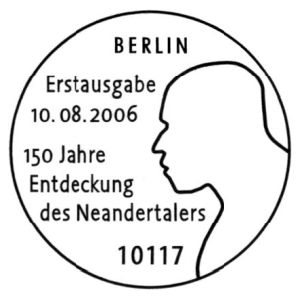 |
 |
 |
 |
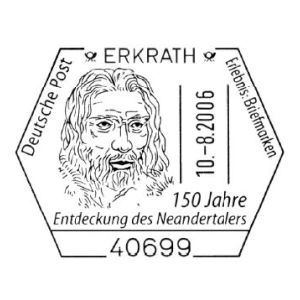 |
 |
|
In addition, to the commemorative postmarks of Bonn and Berlin,
another four postmarks from different locations were issued by Deutsche Post.
The postmark of Berlin was used on the official FDC of Deutsche Post,
while the postmark of Bonn was used on the Souvenir Sheet and anniversary letter.
|
|
| FDC |
| Official |
Anniversary Letter |
Private |
 |
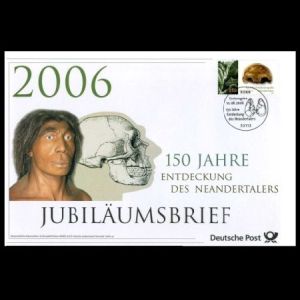 |
 |
|
The anniversary letter (A5 size) includes postcard and information flyer
|
The FDC was signed by by the stamp designer Annegret Ehmke.
The signature is under the bottom-left corner of the illustration.
The reverse side
of the cover has some background information (in German).
|
|
| Circulated FDC letters |
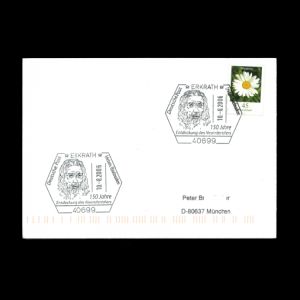 |
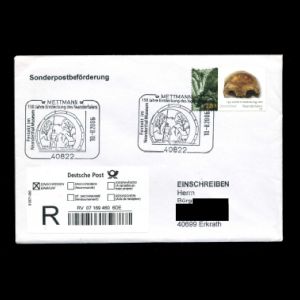 |
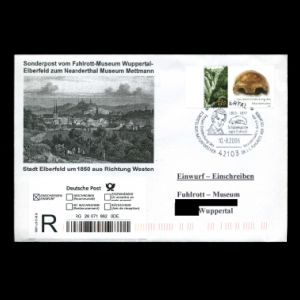 |
|
|
Regular and registered letters, cancelled and posted on the day of the stamp issue.
|
|
| Mini-Sheet |
First Day Sheet |
|
 |
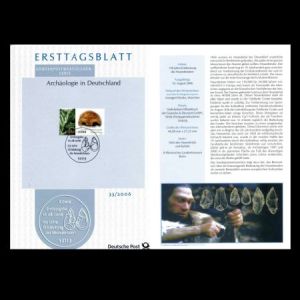 |
|
References
Technical details:
Colnect
Souvenir Sheet
Acknowledgements
Many thanks to Dr.
Peter Voice, PhD Department of Geological and Environmental Sciences,
Western Michigan University, USA, for review of a draft of this article and his very valuable comments.

















